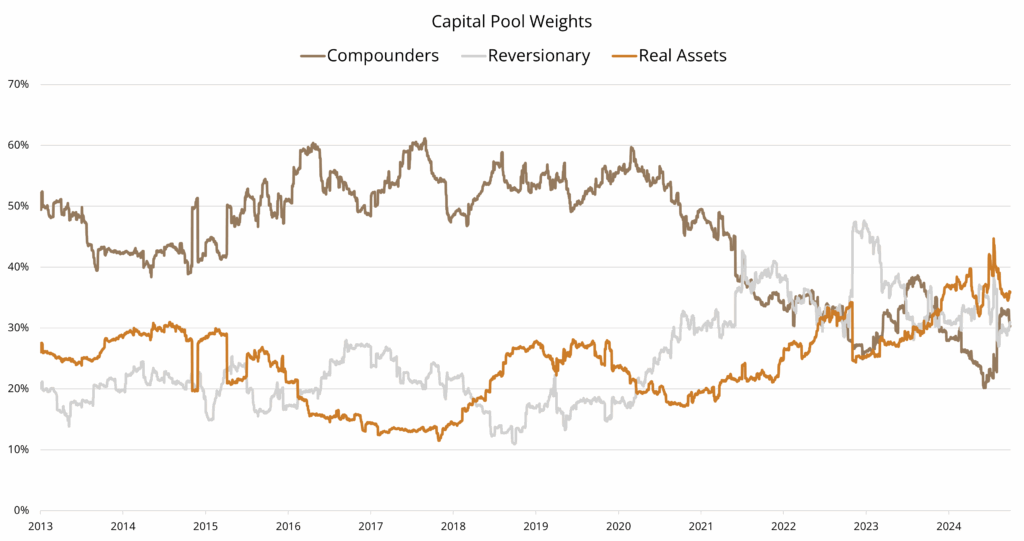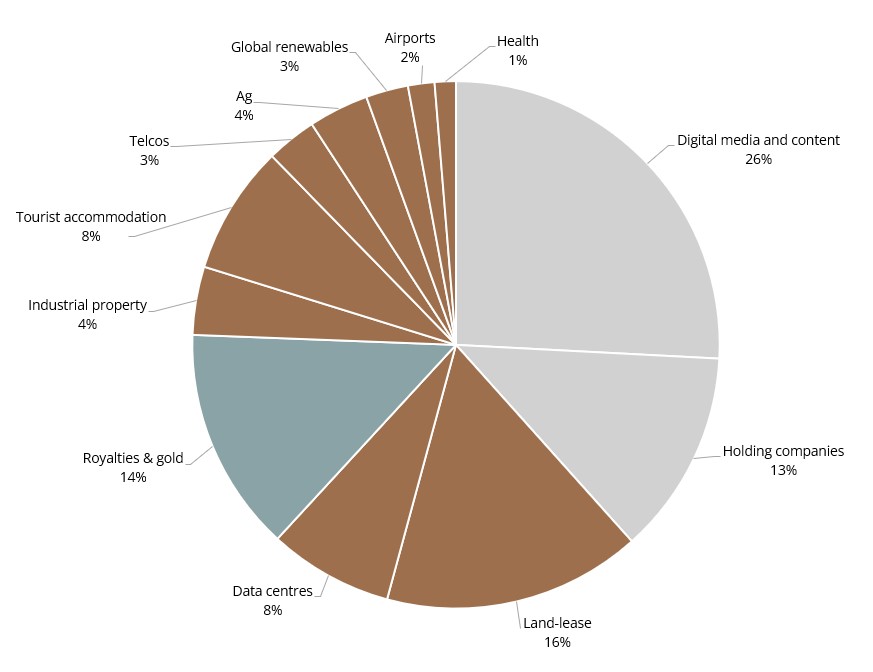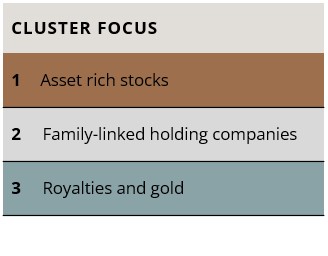Performance Summary
Past performance is not a reliable indicator of future performance
Source: Internal CI data reports, September 30, 2025
Inception Date: 1 July 2004
*Annualised
$100k Invested Since Inception (net)
Past performance is not a reliable indicator of future performance
Source: Internal CI data reports, September 30, 2025
Risk/Return Since Inception (Per Annum)
“Growth, demographics, and liquidity drive the real estate business.”
Sam Zell
Quarterly Highlights
The CI Brunswick Fund returned 2.6% for the September 2025 quarter net of fees and expenses, compared to 4.7% for the ASX200 Accumulation Index.1 Contributors to portfolio performance in the period were Infomedia (IFM), Aspen Group (APZ) and Deterra Royalties (DRR). Stocks that underperformed include Regis Healthcare (REG), Guzman y Gomez (GYG) and Greatland Gold (GGP).
¹ Past performance is not a reliable indicator of future performance.
Portfolio Insights & Market Observations
The September quarter saw a volatile August reporting season – around a quarter of the stocks that reported had an intra-day share price move of more than 10%.² At a broader market or portfolio level the bumpiness netted out with the index returning a solid 4.7% for the quarter, grinding higher as global economies grew steadily and short-term interest rates trended lower (the RBA lowered the cash rate by a further 25bps during the quarter).
Despite the ongoing grind higher, some “top-down” challenges lurk behind the scenes:
- Government debt levels continue to rise across the globe, driven by large budget deficits and an unwillingness to cut spending.
- There has been strong growth in less regulated/shadow lending by private credit providers at a time when parts of the economy remain weak, particularly consumers (most pronounced in the US).
- The “AI” boom has created unprecedented demand for data related infrastructure (data centres and ultimately power), despite a very uncertain return on this investment for big tech.
- Profit margins are at all-time highs with risk this reverts, while valuations appear relatively full at an aggregate level.
- At the same time money is flowing out of actively managed equities into passive strategies, where there isn’t a “fundamental” overlay to the buy decision.
Part of our role as active managers is to be on guard to ensure the Fund’s stocks continue to score well on our VoF investment philosophy and, where necessary, to re-deploy capital into the highest VoF opportunities.
Over the last 12 months we have increasingly favoured our Real Asset and Income Securities Capital Pool – there is more discussion on this pool at the end of this report. More recently per Chart 1, the allocation across the three pools is again roughly even. Note: one of the Fund’s Reversionary stocks was reclassified as a Compounder during the quarter as we viewed its turnaround as having largely played out with the stock entering the next phase of value creation as a Compounder.
Looking forward over the next few years we expect an increase in our allocation to the Compounding pool towards the long-term average of 40-50%, particularly if opportunities emerge in the wake of market volatility. This is likely to include both traditional Growth companies as well as Stalwarts that are growing above GDP but at a lower rate than we would expect for Growth companies (typically we look for Growth companies that can sustainably grow double digits over longer time horizons).
² Source: UBS Research
Chart 1: Capital Pool Weights over time

Source: Internal CI data reports, as at 30 September 2025
During the quarter, the strongest contributor to the Fund’s performance was Infomedia (IFM). Private equity fund TPG Capital made a $1.72 per share takeover offer for the company; a 30% premium to the prior day closing price and a 41% premium to the 3-month volume weighted average price. The Fund owned around 10% of the shares outstanding in IFM at the time of the bid.
IFM was founded in 1987 by Richard Graham, initially offering Microcat—an electronic parts catalogue software that provided a digital alternative to the cumbersome physical documentation used by Australian dealerships. Today, IFM has evolved into a global software provider for the automotive industry, primarily serving OEM dealerships with multiple products.
Our VoF proposition for the stock was based firstly on the many attractive characteristics typical of successful software businesses, including highly sticky customers given IFM’s products are a key part of a dealership’s “operating system”. The proposition was further underpinned by IFM’s strong financial profile—excellent earnings quality, a modest valuation, and a solid, recurring earnings base that was growing over time, albeit at a mid-single digit rate.
We were also attracted by IFM’s strong balance sheet, with ~15-20% of its market capitalisation held in net cash, which could be described as lazy considering money had been raised five years prior with the intention of making opportunistic acquisitions in the wake of COVID-19 (only two small acquisitions were subsequently made). We also undertook detailed work on IFM’s operating efficiency and margins and believed the cost structure could be optimised to boost earnings by at least 30%.
Over the 18 months following our initial investment, we engaged extensively with IFM Directors and management to develop a clear strategy for maximising shareholder returns via strengthening the Board, refining management incentives, optimising capital deployment, and improving cost-efficiency.
The combination of attractive value latencies also drew the attention of private equity and in our view TPG will make a good return from this investment. It is worth noting this is the third small-mid capitalisation technology stock held by the Fund that has been bid for in the last five years.
During the quarter, a significant detractor from performance was Regis Healthcare (REG). In a “two-steps forward, one step back” process, the Government (regulators and Treasury) appear to have walked back on some of the improved funding outcomes for the sector that had become our base case following the new bi-partisan Aged Care Act.
Put simply, the Government funds the Aged Care sector via two components – firstly provision of Care services and secondly for accommodation and other additional/non-care services. The Care component is funded under what is known as the AN-ACC model. REG will receive a 2.6% increase in funding based on its specific resident mix (acuity) under AN-ACC. This increase is supposed to ensure operators recover costs such as known wage increases from Fair Work, EBAs and other areas. However, a 2.6% increase is significantly less than the expected increase in REG’s costs (4-5%).
Near term this impacted both REG and the sector’s earnings recovery. REG was forced to update the market on its estimate for FY26 EBTIDA which, while ~5% higher at the midpoint of guidance vs FY25, was ~10% lower than consensus estimates. Given REG has made acquisitions, the implication is profitability in the base business is going backwards in FY26.
Although the Government has provided other sources of funding increases via accommodation supplements and changes to RAD retention (operators will retain a portion of the refundable accommodation bond as payment), the broad expectation was funding for Care would be sufficient to ensure a relatively stable margin for the sector, given the Government had imposed requirements for minimum hours of staffing (known as ‘care minutes’) in the wake of the Royal Commission.
Another outcome of the funding update counter to logic is that it appears to favour the lowest acuity residents. Given the tightness of supply/demand, operators are therefore likely to favour low acuity residents going forward which would put additional burden on the public hospital system, at a much higher cost to the Government.
In our view this tightening of funding to the sector is a risky approach given the dire state of supply/demand of beds. REG made clear via an update to the ASX that all greenfield/capital investment projects are now under review. Having created a more certain investment environment for operators with the new Act, this latest move could once again prompt a capital strike.
Despite this setback, we are still confident that over the medium term, the new Aged Care Act and ongoing scrutiny of the level of Care funding will ultimately support the profitability of operators within the sector. If the funding outcome doesn’t materialise, the opportunity in REG will be longer dated as the lack of supply leads to significant increases in the prices of existing beds, with ongoing opportunities to acquire operators who are likely to come under financial stress.
Capital Pool Focus - Real Asset & Income Securities
During September, we held the annual update for the Brunswick Fund at the MCC’s Long Room.
 A focus for this event was the Fund’s Real Assets and Income Securities Capital Pool as this Capital Pool was a key driver of the Fund’s returns in FY2025 and over three and five year periods (which we detailed in our annual letter FY2025). The strong performance of the pool in part reflects the supportive backdrop of higher inflation, expansionary monetary policy, and political and economic uncertainty.
A focus for this event was the Fund’s Real Assets and Income Securities Capital Pool as this Capital Pool was a key driver of the Fund’s returns in FY2025 and over three and five year periods (which we detailed in our annual letter FY2025). The strong performance of the pool in part reflects the supportive backdrop of higher inflation, expansionary monetary policy, and political and economic uncertainty.
Our definition of Real Assets and Income Securities is broader than others. We currently focus on three main subcategories:
- Asset-Rich Companies: Primarily real estate and infrastructure, particularly specialised or niche areas over the broader groups of retail, and office. A good example is Aspen Group (APZ). This sub-category can also include agricultural linked stocks.
- Family-Linked Holding Companies: Mostly diversified holding companies like Brickworks, Soul Patts (SOL), and News Corp (NWS), often trading below their fundamental value. We favour stocks with an ability to redeploy capital into attractive markets over time and grow their net asset value per share. The family backing gives us confidence to deploy capital when these stocks trade well below our estimate of fundamental value. We also include listed investment companies [“LICs”] in this group.
- Royalties and Gold Companies: Royalty companies are a higher quality exposure to commodity prices as they don’t typically have the same operating and investing risk of most mining companies. At present, Deterra (DRR) which was spun out of Iluka several years ago, is the only investable royalty company on the ASX and is held by the Fund. DRR holds a royalty over BHP’s Mining Area C, an iron ore hub in the Pilbara. The hub is very significant – it includes 8 open pit mines and three processing plants with BHP recently spending around $5bn to develop the area known as the “South Flank”. We invested when DRR’s share price fell materially, following its first acquisition of a UK listed royalty company (Trident) with the main asset being a royalty over a large US based lithium mine. Given the limited number of listed royalty companies in Australia, we also look for exposures offshore.
Below we show how the composition of the Real Assets and Income Securities pool by subcategory/sector:
Chart 2: Real Assets and Income Securities by subcategory / sector


Source: Internal CI data reports, as at 30 September 2025
Recently, we have further analysed the performance characteristics of these three subcategories within the Real Asset and Income Securities Capital Pool. To do this, we created a portfolio of each subcategory based on the relative weights that we held of each of the stocks in these categories over time.
Over the past 11-12 years, while the returns have varied, the asset-rich group has been the standout, delivering a 23% p.a return (gross of fees). Family-linked holding companies performed well at 16.2% annually, significantly above the index's (ie the ASX200 Accumulation Index) return of 8.8% p.a. over that time.³
The Gold and Royalties category has only been a focus of ours in more recent years. The chart below shows the returns of each category over the last three years.
³ Past performance is not a reliable indicator of future performance.
Chart 3: Real Assets and Income Securities - returns of subcategories

Source: Internal CI data reports, as at 30 September 2025
These subcategories also exhibit low correlations to one another and to the broader ASX. Royalties and Gold show near-zero correlation with the other two groups, and the correlation between family-linked companies and asset-rich companies is also low at 0.2x. This low correlation aids the robustness of the broader Real Assets and Income Securities capital pool.

Source: Internal CI data reports
Regional Exposure
Capital Pools
Market Capitalisation
Since Inception Net Returns in Up/Down Markets
Past performance is not a reliable indicator of future performance
Source: Internal CI data reports, September 30, 2025
Portfolio & Risk Metrics
| Portfolio | Benchmark | |
|---|---|---|
| Price/Earnings | ||
| Yield | ||
| Price/Book | ||
| Net Debt to Equity | ||
| FCF Yield FS | ||
| Forecast Earnings Growth | ||
| Return on Equity | ||
| Tracking Error | ||
| Beta |
Further Information
Looking for further information regarding the Fund, please don’t hesitate to get in touch:
